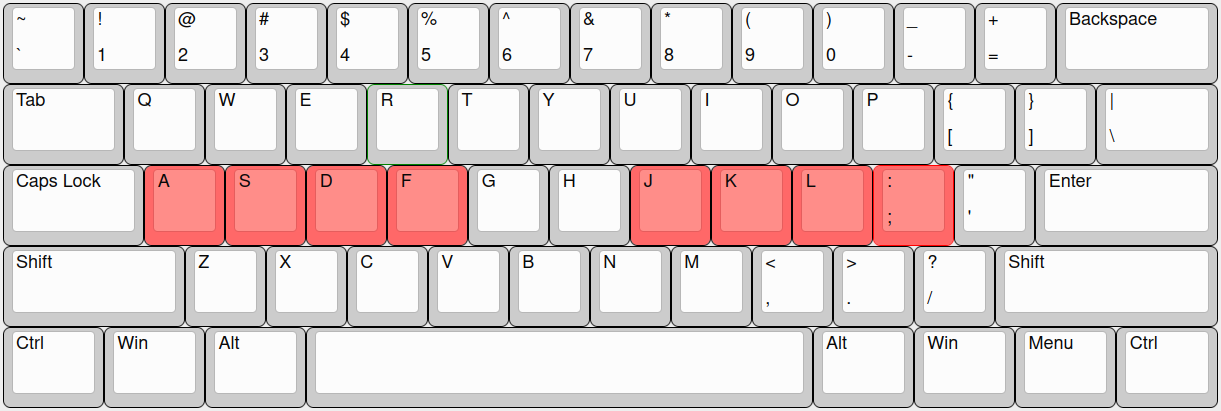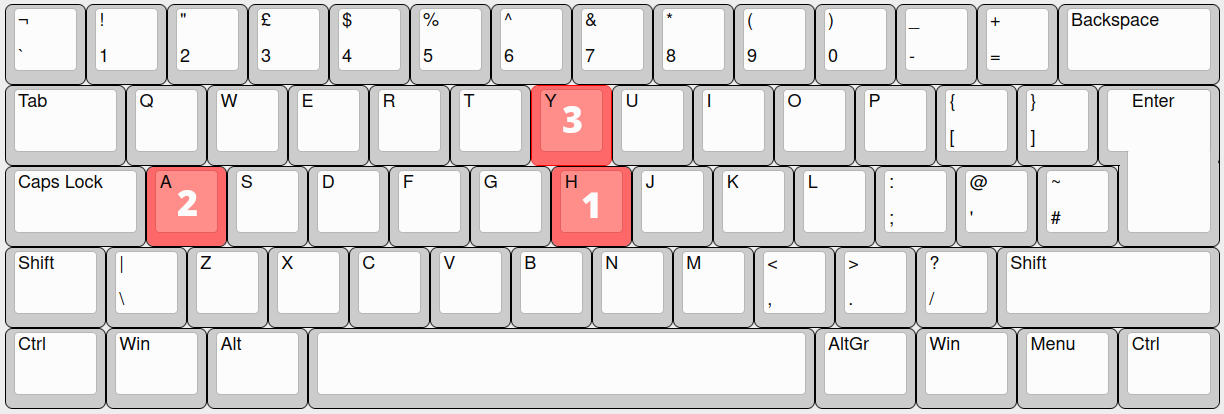Terminology - GalileoBlues/Layout-Wiki GitHub Wiki
Homerow
Most alternate layouts are based around the Homerow method of typing using the middle row of a standard keyboard

the red keys indicate the keys where the user would be resting their eight fingers dividing the responsibility of each finger to 3 keys except the index fingers which are responsible for 6 keys
Finger Terminology
Sometimes fingers may be referred in short-hand with two letter codes, The first letter denoting the hand used and the second denoting the finger used.
| Left | Right | |
|---|---|---|
| Thumb | LT | RT |
| Index | LI | RI |
| Middle | LM | RM |
| Ring | LR | RR |
| Pinky | LP | RP |
Same Finger Bigram (SFB)
Same finger Bigrams or SFBs as we will refer to them from this point onward are when a finger is forced to type two letters by the same finger together with examples below on qwerty such as 'RT' like in the word smart, 'ED' like in the word education and 'AQ' like in the word aqua.

this is seen as the worst metric to have in a layout but with only 10 fingers and 30 keys it is unavoidable, generally the objective is to pair letters so that you have the most useful letters together but the least amount of clashes. here are SFB percentages of popular layouts for contrast:
DISCLAIMER: Metric percentages change based on the text, metric definitions and mathematical implementation.
Qwerty: 4.5-6.6%~
Dvorak: 1.9-2.7%~
Colemak: 1-1.3%~
Workman: 2.2-2.9%~
Same Finger Skipgram (SFS) / Disjointed SFB (DSFB)
SFS or DSFBs are when you press two keys with the same finger like an SFB but it is separated by another letter inbetween. Examples would be the word 'hay' on qwerty.

Lateral Stretch Bigram (LSB)
LSBs are when a word requires a bigram large lateral movement like for example the word beyond on qwerty which has three LSBs (be,yo,on):

LSBs are part of the criticisms with Colemak having to do with D and H specifically, A sizable amount of people find it uncomfortable enough that a modified version that places them below the homerow called Colemak DH mod has become extremely popular in recent years.
Colemak and Colemak DH mod:

Alt-fingering
Not to be confused with Alternation, Alt-Fingering is using a different finger to press a key than the traditional typing technique such as pressing 'b' with the right hand on qwerty or typing 'z' with your ring finger rather than your pinky finger.
Traditional touch typing fingerings:

Angle Mod
Wide Mod
Alternation
alternation is alternating hands with each letter typed, An example of alternation would be typing 'us' on qwerty.

NOTE: Some layout generators and/or analzers consider Alternation to be three consecutive letters each one switching hands instead of just two letters.
Here are some alternation percentages for popular layouts:
DISCLAIMER: Metric percentages change based on the text, metric definitions and mathematical implementation.
Qwerty: 14.2-26.2%
Dvorak: 23.7-44.3%
Colemak: 15.7-30.1%
Workman: 15.3-29.3%
Rolls
Rolls are typing a two letters on the same hand going in the same direction examples are 're' and 'er' on Qwerty.

Rolls are generally considered to be a good metric for speed and is desired in most layouts, this can be broken down into two sub-categories of In-rolls and Out-rolls the 're' being an Out-roll and 'er' being an In-roll.
NOTE: Some layout generators and/or analyzers consider a roll to be two consecutive letters in the same direction on the same hand followed by another key on the other hand.
Here are some Roll percentages from popular layouts:
DISCLAIMER: Metric percentages change based on the text, metric definitions and mathematical implementation.
Qwerty: 20.4-36.9%
Dvorak: 21.5-38.4%
Colemak: 24.7-45.7%
Workman: 23.4-43.3%
One-Hands
One-Hands are just like rolls in that they are a sequence of letters in going in one direction one the same hand but they are three letters or a trigam instead of a bigram, An example of a One-Hand on Qwerty would be 'wer' as in "weren't" or 'rew' as in 'brew'.

NOTE: Some generators and/or analyzers don't distinguish between Rolls and One-Hands as they consider a Roll anything above two letters in the same direction.
Redirects
Redirects are letters in the sequence that change direction consisting of three letters or more on the same hand much like Rolls or One-Hands, An example of a redirect would be the word 'are' on Qwerty whereas 'aer' would be a One-hand.

Redirects are considered to be a bad metric by some citing that the patterns can be uncomfortable or cause accuracy issues whereas others don't mind them and see them just as One-Hands that have a different pattern.
Here are some Redirect percentages from popular layouts:
DISCLAIMER: Metric percentages change based on the text, metric definitions and mathematical implementation.
Qwerty: 7.8-13%
Dvorak: 2.3-3.3%
Colemak: 6.4-10.5%
Workman: 6.4-10.3%
Hardware layouts (Key formation)
Row-Staggered
Row-Staggered or Row-Stag for short is the standard key formation for most keyboards, ANSI Row-Stag key formation pictured below:

Ortholinear
Ortholinear or Ortho for short is when all the keys all placed uniformly spaced apart from each-other, Planck 40% pictured below:

Columnar-Staggered
Columnar-Staggered or Col-Stag for short is when the columns of the keyboard are staggered to compensate for finger length, Atreus pictured below:
